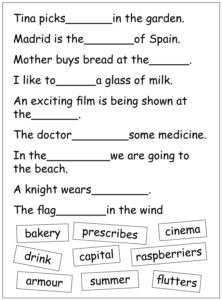Working with gap-fill exercises is a more traditional, rather passive-reproductive type of approach, which can also be used to assess how much learning has taken place. This type of exercise contributes to increasing students‘ active vocabulary only with additional practice of the target words in an applied context.
Procedure: The instructor prepares a worksheet with a text that has some gaps, which must be filled with the missing words. (“Tina picks _______ in the garden”; “Madrid is the _________ of Spain”). It is also possible to use illustrations which must be labelled.

- Simplified variant: fill in the gaps with the appropriate word from the list below. This approach is suitable for 1st–2nd graders( (simple sentences and words), as well as for factual topics where a specific vocabulary word is required. Example: a factual text about farming, or a diagram of the human body; a map of rivers where the correct word can be written in the correct place. Prerequisite: the materials must have been previously discussed in class.Follow-up: the students then write their own sentences, using the words from the exercises.
- More difficult variant: the students must find the missing words themselves to fill the gaps. Here, too, the prerequisite is that the material has been studied previously (including the terms in the standard language and orthography). If it is clear which terms have to be inserted into the gaps, this approach is suitable for learning assessment (e. g. for terms from national history). In other cases, various answers may be possible and can be discussed (e.g “Dini _______ through the bushes, he was very frightened”. Answers: hurried, sneaked, ran…).
- Variant “poems/rhyming words”: filling the gaps with words that rhyme. The difficulty level can be increased, depending on the level of student proficiency. Example (for the lower levels): “In a house/ there lives a ___________ “.
- Gap-fill exercises can fulfill special and interesting functions in language diagnostics when grammatically important elements, such as case endings, or articles are left out and must be filled into the gaps. Example: “Toni is afraid __ the dog”; “I am going to give ____ mother a kiss”. For this exercise, the base form of a verb may be given in brackets, which then has to be changed into the correct form: “Zuza was in Italy. She (to spend)________ her vacation there”). The results provide valuable information about the students‘ grammatical competence in their first language.






